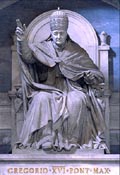 |
| Grottoes
Vatican City Colonnade Saints Floorplan #2 |
| Altars
Monuments The History |
| Related
Sites Gregory XVI |
|
Gregory XVI was the last monk to be elected pope. The bas-relief on the urn portrays the Institution of the Missions by the Pontiff. The two allegorical lateral figures represent Wisdom (head crowned by a flame) and Prudence (with a mirror and a snake). On the base
there is a door leading to the Chapel of the Blessed Sacrament.
|

|
From:
'St. Peter's Basilica - A Virtual Tour'
by Our
Sunday Visitor
The monument is clearly inspired by Canova, with noteworthy though not
very satisfactory results, especially with regard to the general composition,
which is rather incoherent and monotonous in its linear arrangement.
The Pope, in the act of blessing, is at the top, seated on a throne, which in turn is located on a base that rises over the sarcophagus. Above the sarcophagus a bas-relief depicts a scene referring to the propagation of the Faith, assiduously supported by Pope Gregory XVI with the institution of the Catholic Missions (as a Cardinal he was the Prefect of the Holy Congregation for Propagating the Faith).
There are two symbolic figures on the sides representing Knowledge, with the head crowned by a flame, and Prudence, with the features of the mirror and the snake; works with a classical style, because of the meticulousness and technical skill, even if a bit frozen due to an excessively Neoclassical style.
From: 'Lives of
the Popes'
A Camaldolese monk (and the last monk to be elected Pope), Gregory XVI
was one of the Church's most reactionary popes, employing Austrian troops
on two occasions to crush uprisings in the Papal States and opposing Italian
nationalism, freedom of conscience, freedom of the press, and the separation
of Church and state. At the same time, he was a strong promoter of the
missions.
Gregory XVI founded the Etruscan and Egyptian museums in the Vatican and the Christian museum in the Lateran. By the end of this pontificate, however, the papal treasury had been depleted because of all the military expenditures to maintain order in the Papal States. He was buried in St. Peter's, first in the crypt and then, in 1853, in the basilica proper, with a monument done by Luigi Amici (1817-1887) and funded by the cardinals Gregory XVI had created during his pontificate.
From:
'The Deaths of the Popes' ©
2004 by Wendy Reardon
Died, probably of cancer, at age 81. He had been visibly wasting away
for some time but called no doctor because he didn't want to burden the
state treasury. His praecordia were interred with those of his predecessors
in the Church of SS. Vincenzo e Anastasio, Rome. He was originally buried
in the grottoes of St. Peter's but was moved in 1853 to the basilica proper
to be interred in a fine mausomeum by Luigi Amici. On the tomb monument,
the pope is seated on a throne bestowing the benediction while underneath
in the bas-relief, he blesses the Catholic missionaries. Prudence stares
in contemplation on the right side while Wisdom extends her left arm over
the inscription:
GREGORIO XVI PONT. MAX / S.R.E. CARDINALES AB EO CREATI / ANNO MDCCCLIV
("To Gregory XVI, supreme pontiff. The cardinals of the Holy Roman Church created by him, 1854." - Trans. Fr. Tom Carleton)
From:
'The Catholic Encyclopedia'
During his reign the losses of the Church in Europe were more than balanced
by her gains in the rest of the world. Gregory sent missionaries to Abyssinia,
to India, to China, to Polynesia, to the North American Indians. He doubled
the number of Vicars-Apostolic in England, he increased greatly the number
of bishops in the United States. During his reign five saints were canonized,
thirty-three servants of God declared Blessed, many new orders were founded
or supported, the devotion of the faithful to the Immaculate Mother of
God increased. In private as in public life, Gregory was noted for his
piety, his kindliness, his simplicity, his firm friendship. He was not,
perhaps, a great pope, or fully able to cope with the complicated problems
of his time, but to his devotion, his munificence, and his labours Rome
and the Universal Church are indebted for many benefits.


